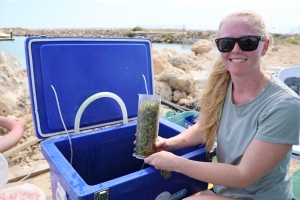Indigenous led research vessel launched with dockside cultural smoking ceremony
A newly-refurbished vessel was launched today to be used for a landmark research, training and environment rehabilitation collaboration in Shark Bay – an area which has been hit hard by devastating marine heatwaves.
The 23-metre ‘Marine 2’ is owned by The Jock Clough Marine Foundation, which offered it to the Indigenous-owned and operated Tidal Moon for its exclusive use. The event took place with a dockside cultural smoking ceremony at Fremantle’s Sardine Jetty.
Tidal Moon has a sea cucumber harvesting business and has applied for a license to help rehabilitate up to 1,000 square kilometres of seagrass in Shark Bay. The meadows were lost just over a decade ago in a series of marine heatwaves.
‘Marine 2’ will enable the training and employment of local Malgana People, as well as marine research delivered by the Western Australian Marine Science Institution (WAMSI) with its partners.
“Seagrass provides a vital habitat and breeding area for marine animals,” Mr Wear said.
“It also prevents the release of thousands of tonnes of carbon dioxide and is regarded as the ocean’s lungs.”
“Myself and Malgana Elders are honoured that Shark Bay’s Traditional Custodians will lead this exciting collaboration which brings together important marine research and innovative projects that benefit the environment.”
“We are combining Western marine science and Indigenous Sea Country knowledge.”
“This is also going to create new private sector job opportunities and give our young people new opportunities to care for Sea Country,” Mr Wear said.
WA philanthropist, businessman and Jock Clough Marine Foundation Co-Trustee, Jock Clough said he was looking forward to supporting the collaborative effort.
“This is a wonderful opportunity for Tidal Moon, with its Traditional Owners and custodians, WAMSI and the Jock Clough Marine Foundation to work together, and really make a difference to the knowledge of a very special place,” Mr Clough said.
WAMSI CEO Dr Luke Twomey said the organisation had developed a Science Plan for Shark Bay (Gathaagudu) and further research would provide essential data to help inform the way local and global marine ecosystems were managed. “Shark Bay is like the canary in the coalmine for climate change and our partner scientists will be able to make a real difference through this initiative,” Dr Twomey said.
Tidal Moon has been working with scientists from WAMSI’s partner institutions and with CSIRO to better understand the role of seagrass in Shark Bay’s ecosystem and the best ways to prevent future losses.
WAMSI manages major marine science projects through its partnership with Curtin University, Edith Cowan University, Murdoch University, The University of Western Australia as well as the Department of Biodiversity Conservation and Attractions, the Department of Water and Environmental Regulation, the Western Australian Museum, Australian Institute of Marine Science and the Department of Primary Industries and Regional Development.

